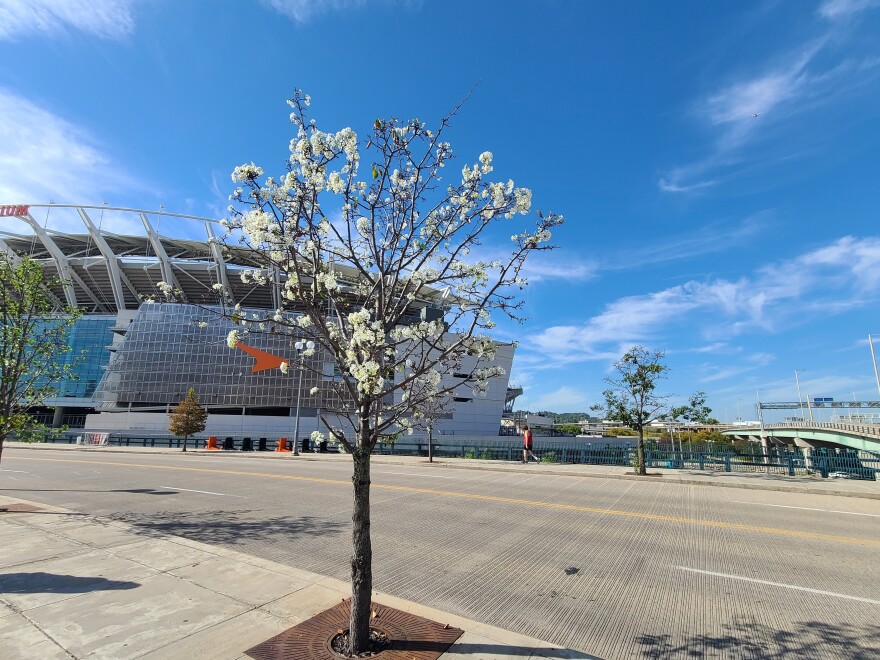In early September, WVXU reported on trees changing their fall leaves too soon. Now there's a new tree phenomenon: second spring.
While walking near Paycor Stadium recently, a smelly scent wafted my way. To my astonishment, one lone Callery pear tree at The Banks was in full spring bloom.
Rather than preparing to drop its leaves for winter, it was showing off small white flowers.
"Essentially that tree is confused," says Garrett Dienno, supervisor in Urban Forestry with the Cincinnati Park Board.
"One of the ways that (trees) can tell what time of year it is and what the seasons are is by the length of darkness ... so how long the nights are, and also ambient temperatures. When you have long nights and very cool evening temperatures followed by really warm temperatures during the day, that tree is thinking, 'Ah, I'm going into the spring, it's time for me to flower.' "
Dienno says this happens especially when we have unseasonably warm falls. The cooler nights we had a month or so ago are probably what triggered this tree to bud out.
Ambient lighting from the stadium and street lights also can play a role in confusing the tree.
While the tree is an odd sight, Dienno says last summer, the park board saw a bunch of trees react this way. It's been less prevalent this year.
"Last year, we had the same issue too, where we were seeing cherry trees blooming in Northside, and we saw the Callery pears in the West End all blooming. And we had trees that had gone dormant, and then they decided ... to break bud and start putting out new leaves."
Like with the leaves changing color too early, stress from lack of rain and drought plays a factor.
Blooming now is bad news for a tree's overall health.
"It should really be trying to get ready to go dormant for wintertime, and spending all your resources and energy into putting out flowers that aren't going to do any good is probably not the best thing for it to do," Dienno says.
He says there's not much to be done to help the tree out. If you have one on your property that's confused about the seasons, you can give it a good mulching heading into winter to help with the stress and keep an eye on it in the spring.
"You could certainly do some liquid feed, or even just a nice compost and mulch on top of that certainly never hurts. The roots stay active until the ground is frozen; those roots will still be absorbing nutrients and moisture from the soil, so it'll help a little bit, probably. But with all the buds breaking, they're not hardened off going into the winter, so the tree is far more likely to suffer from frost damage and freeze damage and all those things that a normal tree would be prepared for," says Dienno.
Why does Cincinnati Parks have Callery pears anyway?
Callery pear trees — sometimes known as Bradford pear trees — come from Asia and were introduced in the early 1900s. They were popular ornamental trees for landscaping because of their adaptability, flowering, fall color, and rounded crown.
It turned out the trees also were aggressively invasive, spreading quickly, edging out native trees and other plants.
Ohio made it illegal to grow, sell, or plant Callery pear trees in 2023.
The Callery trees around the area of The Banks and Paycor Stadium may look fairly young, but Dienno says they've been there a while, certainly before Ohio made it illegal to plant them.
"Those tree wells, and that site are very, very difficult conditions for trees, so they're not growing very quickly or very much per year," Dienno notes.
"It's not a species that we're actively planting anymore, and we are looking at phasing them out as (it becomes) time to replace them. We're not doing a wholesale replacement all at once because that would be far, far too expensive," he says.
In the meantime, the foul-smelling trees do help reduce ambient temperatures, provide shade, and help with stormwater runoff.
"Unfortunately, that was really the only tree that was planted in many neighborhoods, so if we took them all out, there would be no trees. ... Mount Adams comes to mind in particular as far as having a very large number of Callery pears that, if we took them all out at once, there would not be much left. We have to be selective and do it slowly and gradually as we are able to," Dienno concludes.
Read more:



